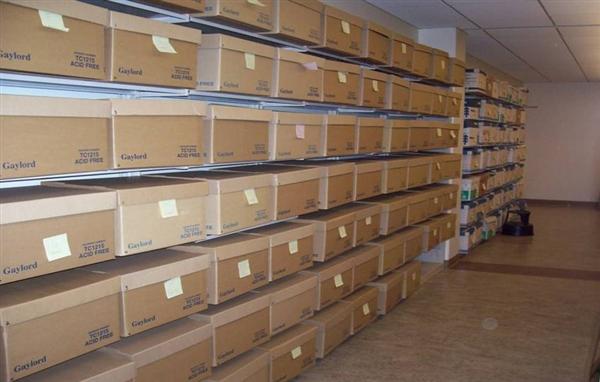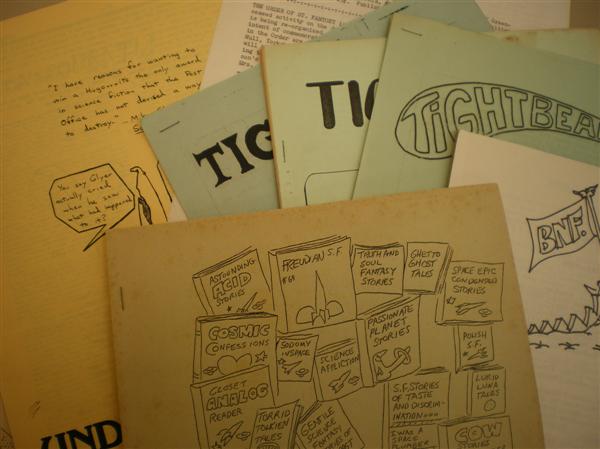1. Introduction

Figure 1. The Eaton Collection Reading Room at UC Riverside's Rivera Library. Photo by Sarah Allison. [View larger image.]
[1.1] The Eaton Collection at the University of California, Riverside (UCR) is one of those nexus places, an archival cantina straddling several different functions in its daily uses and visitors: there's something for everyone, whether student, scholar, archivist, or enthusiast. Located on the fourth floor of the Rivera Library, past the operational printing presses and the glassed-in displays of SF novel covers, its sunlit reading room and cheerful student help render the Eaton Collection vaguely unintimidating—until one gets past the small anteroom and into the collection itself. Then, the holdings stretch out across dizzying, dusty rows, bearing silent witness to the quiet exclamation from someone who just found the dust jackets carefully arranged over, say, the first few impossible-to-find editions of her favorite comic. Or the frail cover of some sfnal treasure in its first translated edition—or perhaps the first edition itself. This vast array of papers, drafts, novels, anthologies, and other print matter evinces a long history of accumulated fandoms, material evidence of lifetimes of passionate enthusiasm all accumulated and accounted for, archived for anyone with a library pass, a yen for context, and a good eye for buried treasure.
2. The Eaton Collection
[2.1] The original Eaton collection was a group of science fiction and horror novels amassed by Professor J. Lloyd Eaton during a lifetime of active fandom (http://eaton-collection.ucr.edu/JLloydEaton.htm). Full of first editions, often signed, the collection numbered in the thousands by the time UCR acquired it in 1969. By 2005, at the end of Curator Emeritus George Slusser's tenure, the collection had grown to more than 100,000 volumes through processes involving both careful cultivation and acquisition, as well as sudden, unexpected beneficence (http://eaton-collection.ucr.edu/About.htm). Today, the collection reliably acquires the latest works of sfnal fiction published in English, while continuing to amass prodigious amounts of archival material, which includes accumulated papers from Gregory Bedford, David Brin, and Anne McCaffrey, a concentrated group of Philip K. Dick texts in various languages, and the 1517 edition of Sir Thomas More's Utopia (http://eaton-collection.ucr.edu/CollectionsAndArchives.htm). Through events like the annual Eaton Conference, the collection seeks to continue opening access by a combination of mixed public and scholarly activities in order to simultaneously foster fan enthusiasm and increase academic consideration, not least because they are often so tightly linked.
[2.2] From its inception, the Eaton Collection has relied on the generosity of fans. In addition to the books, comics, manga, magazines, and various professional and semiprofessional documents that make up its holdings today, the Eaton's fanzine collections in particular come with their own storied provenances. The collections, named after their donors (Carr, Sneary, Pelz), contain over 100,000 individual documents, and record fan activity in the United States stretching back as far as the 1930s, making it one of the largest archives of this nature in the world (http://library.ucr.edu/?view=collections/spcol/fanzines.html). Slusser's homage to the fanzine as a specific medium of fandom involvement, foreshadowing the rampant interpenetration between canon and fanon today, can be found at the fanzine exhibit online (http://eaton-collection.ucr.edu/fanac/Index.htm). Proudly flying its fanac fan history roaring-rocket banner, the exhibit roots itself through replicas of the twilltone paper and rusty staples of its subject matter, and details the history of the science fiction fanzine while linking to covers of specific examples from Eaton's own holdings. But the immediate involvement of fandom at large in the fanzines' archival preservation remains somewhat obscured, even in Slusser's careful mosaicist's rendering. Melissa Conway's expert recollection helps flesh out the interstices.
3. Interview with Melissa Conway

Figure 2. Shelves full of unprocessed fanzines from what would eventually become the Pelz collection, and disgruntled student, name unknown; dated 2002. Photo by Melissa Conway. [View larger image.]
[3.1] "When Fred Patten had a stroke, he was in the hospital for a long time. His landlord came by and said, 'You're not coming back, clean this place up or I'm going to put everything on the curb.'" Dr. Melissa Conway is the head of special collections for UCR, and came to UCR after stints with Yale's Beinecke Rare Book and Manuscript Library and the Library of Congress. I interviewed her at UCR on December 8, 2010. She vividly recounts the Patten collection's storied arrival at the Eaton Collection:
[3.2] The fans organized themselves. I got a call from the fans. Will you take it?…Within days they had everything here, boxed beautifully, they helped Fred get a right wheelchair, they did his legal and taxes…They were really there for him in a time of just incredible stress. I had not been aware of the fandom community before this job, so six years ago, and this experience was almost the first. It was beautiful.
[3.3] Conway's work with the Eaton Collection has brought her into some strange new worlds; as she put it, "I was at a bar mitzvah once and mentioned that I worked with the largest science fiction collection in the country…Suddenly I had a tableful of 17-year-old boys asking me questions out of nowhere!" Conway's involvement with the Eaton Collection began with an immediate introduction to the vagaries of fanac, or fandom activities: "Bruce Pelz was a librarian at UCLA—he hoarded every fanzine that came his way. He died very sudden." They had met, briefly, and spoken only a little of what at the time was Conway's new job. A medieval scholar and specialist in rare texts and archives, Conway's expertise had not previously led her to the shoals of involvement in SF fandom, although she was already quite familiar with the idea of a learned community of response. Pelz's huge collection, already famous during his lifetime, had an uncertain future after his passing. She continued, "I was away at a conference when I got a message from his wife: he was sending us the collection. In they came…They had been stored in all different ways, they were in boxes," and a powerful manyness of them, too. John Hertz of File 770 describes the numbers this way in May 2009: "Eaton [the Eaton Collection] had kindly made a flier which spoke of 50,000 Pelz fanzines. Was this a typo? We had long heard of 250,000. Actually there are about 70,000—someone rounded down—but indeed something happened. Space. Pelz had a lot of fanzines, like many collectors had acquired others' collections, and had never gone all through to organize the lot" (http://file770.com/?p=1105).
[3.4] So the Pelz collection arrived, unbidden, bringing with it the widespread attention of extant fanzine scholars, as well as one of the major difficulties of archiving fan works. "They came in," said Conway in well-remembered dismay, "and there was no way to catalog them." The UCR libraries currently include the entire Carr fanzine collection; the Carr collection came earlier, and is currently organized under "fan magazines" within the general library database. By contrast, the Pelz collection has its own database, an annex housed under "Fanzine Collections Search" (http://library.ucr.edu/?l=fanzine&browse=true). It serves as a rough guide to a mass of text that, according to both Conway and Hertz, its amasser had never managed to fully chart (http://file770.com/?p=1105). The Pelz collection's arrival may have spurred Conway's already developed archival passion toward the kind of fanzine cataloging event that could happen only with massive input from various sources—of funding, of knowledge, and most of all, of time.

Figure 3. Fanzines in the stacks, processed and stored in acid-free archival boxes. Photo by Melissa Conway. [View larger image.]
[3.5] Conway's biggest hope for the fanzine collection is a catalog—not just a serial catalog, not least because serial numbers have no applicability in this case, but an analytics catalog, with individual entries for each part of every fanzine's table of contents. The catalog would be an integral part of a larger digital fanzine project, something she has seriously discussed with Professor Rob Latham, whose responsibilities include editing Science Fiction Studies and hosting the annual Eaton Conference. Scholars, readers, and fans worldwide would be able to find individual contributions, opening fanzines to the scrutiny of the curious. The level of precision desired is equaled only by the amount of work required to achieve it; Conway's estimate of the cost, for all fanzine holdings across the United States, is in the millions: "That's a level of cataloging that doesn't exist for most things, not even journal articles."
[3.6] However, the opening of fanzines to a wider audience would mean that for the first time, these fan made documents could travel well beyond their intended readership. Beyond issues of copyright, discussion of digital reproduction of the fanzines gives rise to a series of difficult, fandom-centric questions about exposure, access, agency, and decision making. Open access to the fanzines could expose fans who cherish the relative anonymity of limited off-line production, and disregard fans who want their work or their names to remain within the fandom—and that's just for a start. When I broached the issue with her, Conway's response was immediate: "The [fan]zines are public. But that is a good point."

Figure 4. A very small selection of fanzines from the Eaton Collection's holdings. Photo by Regina Yung Lee. [View larger image.]
[3.7] Conway sincerely doesn't want to unthinkingly replicate the privileged stance of unquestioned knowledge-access. Instead, she says, she would want to hear from the fans before she proceeds: "If people feel threatened, we would adjust for that. I want to hear from [the fans]. I want to do this in a way that people don't feel threatened or destabilized by that [process]." Ideally, the archivist would straddle the same set of worlds as the fanzines themselves, and be conversant with the creators' visions, as well as the fans' fears: "My dream cataloger would be someone who knows the fan community as well as the texts…[Someone who] would talk to the fan communities: 'Do you like this? Is this helpful?'"
[3.8] Despite her digitized dreams, Conway refuses to consider giving up the originals. Beyond their status as often unique copies, which she champions with a true archivist's zeal, she considers their physical instantiation a crucial part of the critical imprint of the fanzine's historical significance. Asked to expand, she grew near rhapsodic as she detailed the ways in which the physical fanzine yet holds the trace of the enthusiast:
[3.9] Maybe it's because I am a rare book person, but touching a rare manuscript and touching a facsimile, there's an extra dimension that I learn from seeing the actual gold leaf, the tempera paint, the brush textures; to me that's a whole different sensual experience as well as a different level of education. It's the same way with the fanzine. I think I would not have the same experience of relationship with the author who created the zine [without that physical copy].
[3.10] She paused, long enough that I feared a dropped phone or a lost connection. "I would always want to have that extra layer, that extra texture, of the relationship with the manuscript," she finally concluded. "There's a similar sense of the immediacy." Her value for this persistence is something she readily admits might well be romanticized, but it sounds suspiciously familiar. One could say I recognize her enthusiasm.
4. Conclusion
[4.1] The complex issues of provenance and archiving may seem like a side note to many, perhaps even to many of the fans themselves; why bother with the letters and opinions from decades ago, what worth their preservation? Conway's answers to these questions reveal that she considers her work with the Eaton Collection a modern-day form of her work at Beinecke. "What makes the fanzines distinctive is that they are essentially ephemera, produced by the fans for the community, and give incredible insight into what nonpro people in the fandom community were talking and thinking about across more than 70-80 years. As someone who has worked on medieval texts, my god, what wouldn't I do [for something similar]…Dear Lord, what could that tell me about the medieval ages?" Slusser's exhibit points the preservation question forward again, positing the question concerning fanzines' archiving (and potential propagation) as a question concerning fankind. Slusser's historically focused, fanzine-centric enthusiasm leads him to posit the fanzine as the precursor to the currently Internet-driven fandom paradigms of near-instantaneous call and response: "The essential function of the fanzine is to generate and disseminate the interaction of an optimal number of participants, pushing the limitations of the print medium to its maximum speed and range in terms of its ability to produce interactive dialogue. In this sense, the fanzine is the forerunner of the Internet" (http://eaton-collection.ucr.edu/fanac/Page68.htm). Perhaps more specifically, the preservation of the fanzine could be seen as a kind of recognition, an acknowledgment of contemporary fandom's inheritance of the fanzines' tight focus and critical response toward a set of genres whose popularity once stood somewhat askew from accepted mores. This curatorial stance allows for concentrated action as well as scholarly consideration; indeed, for material evidence of fanac under stringent conditions, surely today's communities of enthusiasts need not look too far.
5. Acknowledgments
[5.1] With thanks to Dr. Melissa Conway for her time and expertise, and to Prof. George Slusser, for letting me back there in the first place.